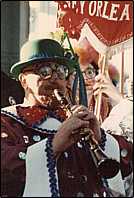Carnival
in New Orleans
By
Janice Clark
The New Orleans Carnival in America is similar to the Fasching in Switzerland and Germany which begins on the twelfth night after Christmas and continues until Shrove Tuesday. The expression "Mardi Gras" is from the French, meaning "Fat Tuesday". The season officially beginsf on the Epiphany, Kings Day, the first Thursday in January with balls and parades leading up to a frenzied climax on the first Tuesday in March, Mardi Gras Day. Unlike anywhere else in the world, from a wrought iron balcony one can observe a jazz funeral during the festivities, while dining on crawfish or pecan chicken or a bowl of jambalaya, finishing with bananas foster or a slice of the famed King Cake.
 |
| photo by Fred Hatfield |
The French in New Orleans were having private masked balls and parties as far back as 1718. When the Spanish governed the area, however, parties and street dancing were banned. Not until 1827, was the right to party in mask was restored, after a group of students, recently returned from school in Paris, donned strange costumes and danced their way through the streets. Mardi Gras escalated each year, eventually culminating in an annual Mardi Gras ball. In 1833 Bernard Xavier de Marigny de Mandeville, a rich plantation owner, solicited a large amount to help finance an organized Mardi Gras celebration. In 1837 the first Mardi Gras parade was staged, consisting of a single float which, though crude, was a great success.
The city's elite and their elegant Mardi Gras parties were quite a contrast to the wild partying and near-rioting in the streets, and it became apparent that all celebrations were in danger of another ban. In 1857, a group of men formed a secret society called the Mystick Krewe of Comus. They wanted to preserve Mardi Gras by planning, organizing, and managing the celebrations. Comus held the first theme parade and used flambeaux to light the procession.
To entertain the visiting Grand Duke Alexis Romanoff of Russia, the Krewe of Rex was formed in 1872. Since America has no royalty, the men in Rex created a King "for the day" so the Grand Duke could be royally received. They secretly anointed anointed a society member named Mr. Halliday to be the King of Carnival. Even today, many parades keep their King's identity a secret until parade day. It soon became known that the Grand Duke's reported mistress, an American actress named Lydia Thompson, was appearing in New Orleans during the Duke's visit. The parade band's official theme then became "If Ever I Cease to Love You."
Mardi Gras even mocks itself on occasion. The Black New Orleanians mocked the snobbishness and exclusivity of Rex with their own parade. In 1909, William Storey wore an old tin can for a crown instead of the more elaborate crown Rex used. William was crowned "King Zulu" that year, and was proceeded by "Provident Prince" and the "Big Shot of Africa." Donning black face and white eyes is another pun of the Zulu Social Aid & Pleasure Club. Zulu's parade would meander through bar rooms in junky cars and wagons instead of floats. To catch the start of the parade, one had to find the bar that was extending hospitality to King Zulu. Zulu's beautiful floats has become one of the more popular parades. They are known for their unique, hand-decorated coconut throws.